January, 2020

Themes from Our Past
Here are some of the events and trends in the long life of South Coast Orchid Society that we can credit for our existence and our continued survival in Long Beach, California. We weren't particularly careful to preserve our history, but enough survives in the form of newspaper clippings, published notices in Orchid Digest and the AOS bulletin, Orchids, and in scattered newsletters, that we can see the outlines of how we managed to reach our 70th anniversary year.
Oil on Signal Hill!
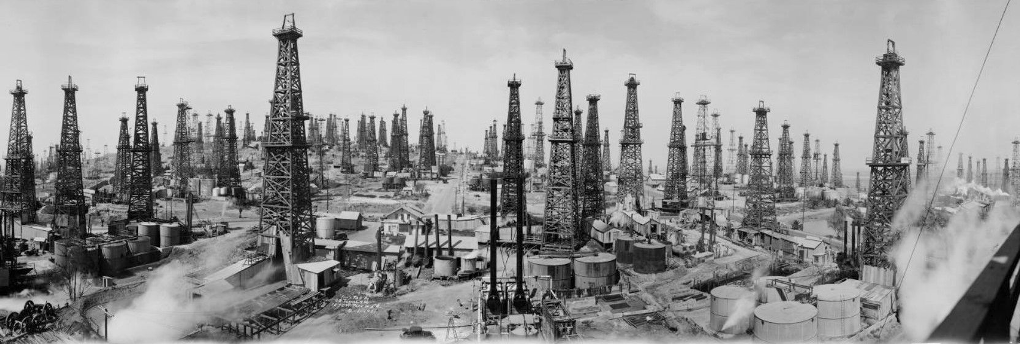
The discovery of oil on Signal Hill (at the time, an unincorporated area just north of Long Beach) in 1921 changed everything. The discovery led to the development of a new industry, an influx of people from many different backgrounds who saw an opportunity to make money, and the rapid development of the entire area. Among the partipants was Samuel Mosher, whose Signal Gas and Oil Company, started with a loan of $4,000 from his mother, eventually became such a giant that Mosher could afford to relocate to the vast Rancho de los Dos Pueblos in Goleta, where he built what soon became the world's largest orchid business, Dos Pueblos Orchids, thus bringing the orchid industry to the Santa Barbara area with Long Beach oil money! Another oilman from Long Beach was Paul N. Baker, our founder and first president, who built two greenhouses next to his office and oil wells just off Long Beach Boulevard on 37th Street.
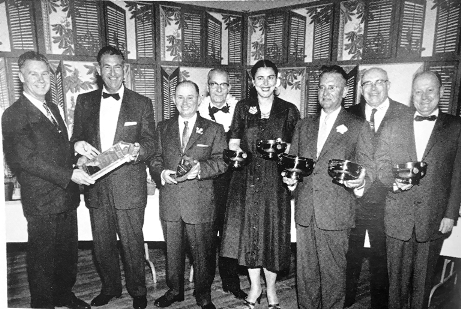
Our first banquet at the new Petroleum Club in 1957
Another oilman, Arthur Falck, was a member of the Petroleum Club in Long Beach (only a block away from Paul Baker's greenhouses and wells). When the Petroleum Club's new facility was completed, Arthur's membership allowed him to reserve the premises for our annual awards banquet on January 28, 1957, and for many years to come.
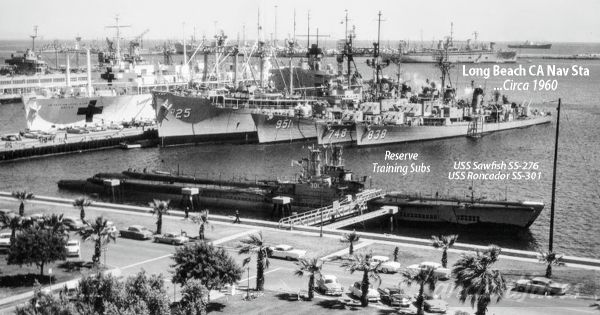
World War II
Many of our members served in the armed forces in World War II. Quite a few were in the Navy, serving in the South Pacific, and ended up in the Long Beach area at the end of the war. Wartime service and industries brought another wave of immigrants to Long Beach from other parts of the country. Some of them had encountered orchids in the places where they had served during the war, such as Hawaii, the Philippines, etc.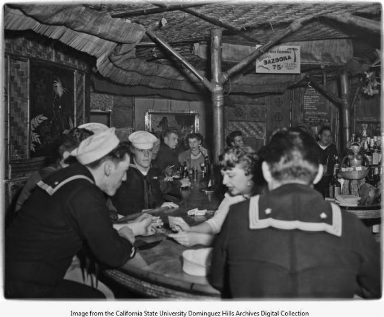
The Postwar Boom
Southern California grew quickly after the war. The aviation industry, transitioning to commercial aviation, was one of them, but the growth involved many other industries as well, such as manufacturing, construction, and of course, Hollywood. Good jobs supported our orchid growers and their families. Like almost all immigrants from colder parts of the US, the new arrivals marveled at the sight of roses blooming in January, orange trees in every back yard, palm trees, and very soon, all sorts of exotic "tropical" plants.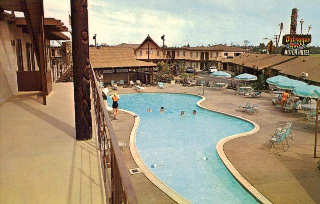
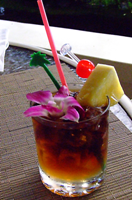
In fact, it wasn't long before a wave of Polynesian style swept through Southern California. For a time, it seemed everyone had a "Hawaiian" back yard with banana trees and tiki torches. The Lafayette Hotel in downtown Long Beach opened an Outrigger Bar, and there was also a famous Outrigger Motor Hotel on PCH. "Tiki culture" was everywhere. On The Pike, sailors congregated at the Polynesian-themed bars. In our early years, SCOS joyfully celebrated "the Islands" with an annual luau, complete with grass skirts and hula competitions, all elaborately decorated with orchids.
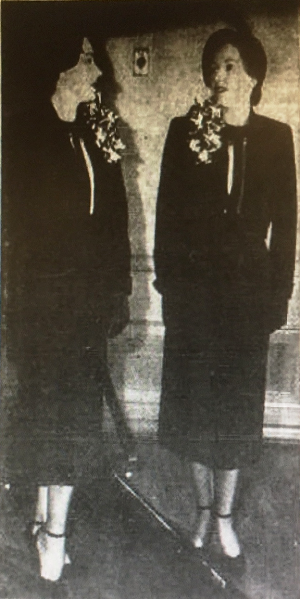
"The lovely Claire Hammel", newpaper clipping on the occasion of our first big party, December, 1950
High Fashion and Corsages
Women's fashions in the postwar era featured a wonderful elegance (which, however, almost everyone was happy to leave behind a few decades later). Our early members found stunning tailored outfits at Dinel's Feminine Apparel in downtown Long Beach, and completed their ensembles with custom orchid corsages, an art form perfected by our members. To support that style, there was also a thriving industry of orchids as cut flowers, although our members preferred to grow their own. The corsages of the day featured graceful flowers with a minimum of ribbon, just enough to hide the stems. Our first spokesmodel, Claire Hammel, an actual department store model, was featured in the local press on the occasion of our first holiday party in December, 1950.Long Beach Parks Department
All the way back to our first known event, the 1950 holiday party, and in every newspaper clipping and newsletter since, our monthly meetings, always on the fourth Monday of the month, unless that date was a holiday, have been held in Long Beach Parks Department facilities. Our awards banquets were held at the Petroleum Club for many years, but everything else was in Parks Department community centers or clubhouses. We are not aware of any other group in Long Beach with such a long and continuous association with the Parks Department.Orchid Nurseries and Backyard Orchid Breeders
Among our early members were owners and employees of just about every orchid business in Southern California. The same people were also usually members of the Orchid Society of Southern California (which met for some years at Plummer Park in what is now West Hollywood; they now meet in Burbank), and we can guess why! OSSC, founded in 1947, has always met on the second Monday of the month, and SCOS has always met on the fourth Monday, so that, no matter when your stunning new orchid bloomed, you would have a chance to show it off at one or the other of these two groups. There were small orchid nurseries scattered all over Southern California, virtually all of them long gone. Our members, both professional growers and at least as many amateurs from all walks of life, exchanged plants and advice at our meetings. They purchased the latest seedlings or won them in plant raffles.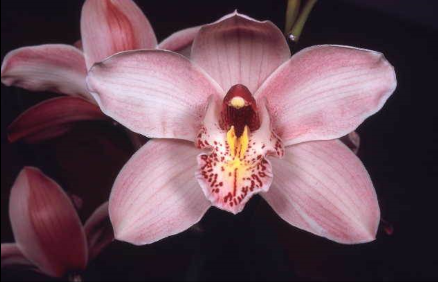
© 1970 AOS
Cymbidium Lillian Stewart 'Monique' AM/AOS, exhibited at our meeting in Long Beach April 27, 1970 by Cobb's Orchids of Santa Barbara, photographer unknown
What caught the attention of our members in the early days? We can see what they were up to from the accounts of our meetings and the awards that were published in Orchid Digest and our newsletters. Cymbidium Lillian Stewart, produced by Fred Stewart, generated huge excitement, something Ernest Hetherington later dubbed "Cymbidium fever". Someone even opined that Lillian Stewart was the world's most highly awarded orchid (not true, in fact). One measure of its fame is that it even ended up on a North Korean postage stamp! Lavender Cattleyas were perhaps even more popular, especially the series of seedlings of what was then Lc. (now C.) Bonanza. The next generation produced Rlc. Memoria Cripsin Rosales, among others. Other members worked on producing superior clones of Cattleya species, such as C. mossiae. Paphs (then still called Cypripedium and Phals were not neglected, either, and the efforts of our members were supported by the best laboratory technicians, some operating out of their homes, others working for the orchid nurseries.
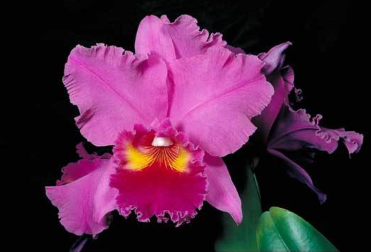
Rlc. Memoria Crispin Rosales 'El Bekal' HCC/OD, exhibited at our meeting in Long Beach August 26, 1962 by A. M. Thompson, but where did the photo come from? We found it in the AOS Orchids Plus software associated with a date of June 29, 1968 (not one of our meeting dates), and the award listed as HCC/AOS, the exhibitor, location, and photographer all unknown, but with the same score, 76 points. When the judging programs of Orchid Digest Corporation and the American Orchid Society were merged at the end of 1967, there were suggestions that the Orchid Digest awards would be recognized by AOS, but we were unable to find any indication that this actually happened. But perhaps a few OD awards actually did find their way into the AOS awards database.
Other members learned how to pollinate orchids and then how to germinate the seeds on the newly-devised sterile media. A few of our members started their own flasking businesses at home. An enterprising housewife from Canoga Park, Grayce Hecker, took advantage of a new invention, a plastic greenhouse, which she used first to grow what turned out to be one of the best seedlings ever of C. Bonanza (she named her plant 'Pay Dirt' and insured it for $1,500), then produced a number of fine hybrids from it. Every month, she and her husband, a restaurant owner, drove down to Long Beach for our meeting.
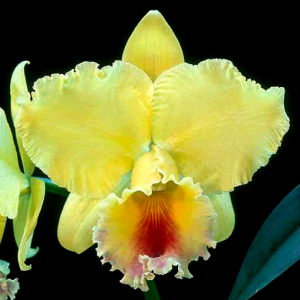
© 2006 Charles Rowden
Rlc. Goldenzelle 'Memoria Roy Field' AM/AOS, exhibited by Ed and Donna Wise at our meeting on March 27, 2006, and named after Roy Field, one of our longtime members
Multiple people in SCOS would sometimes make the same cross — we know this happened in the production by at least 3 or 4 of our members, both amateurs and professionals, of the same cross that was eventually registered as Rlc. Goldenzelle, which can be regarded as an SCOS group project — except that it was likely discussed at OSSC meetings by the same people as well!